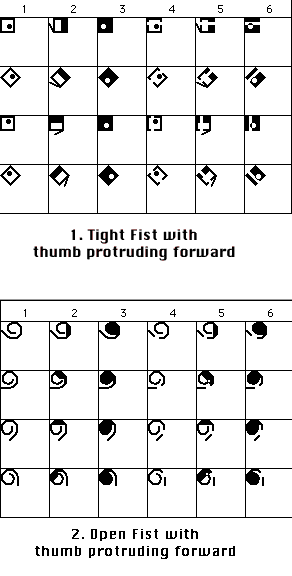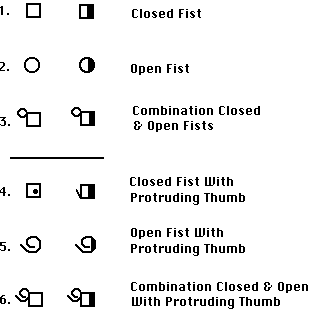|
SignWriting
List
February 7, 2000
QUESTION 0018:
I'm in the middle of transcribing material in Jordanian
Sign Language (LIU = "lughat ul-'ishaarat il-'urduniyya"),
and have run into a handshape which I have not found in
the SW material. It is a tight fist, with the tip of the
index finger touching the inside of the thumb knuckle.
If you look at the thumb side of the hand, it resembles
a written "9" -- which is good, since it is
a signed number "9" in LIU, as well as a fingerspelled
letter "waw". LIU also has a two-handed form
of "9" ("4+5", as used in international
gesture), but I'm not composing -- I'm transcribing. Any
ideas?
ANSWER
0018:
First, take a look at this web page:
Brazilian
Fingerspelling Keyboard
and look at the Brazilian number 6 and 9. Both use that
handshape as an open fist.
|
EXAMPLES
0018

Example
0018 above shows the tight fist with a protruding thumb,
and the open fist with a protruding thumb. It shows different
rotations and palm facings to give you an idea how the
symbol looks as the hand turns. The
dot in the middle of the square represents the protruding
finger....the side view shows the side of the finger....
|
|
SignWriting
List
February
8, 2000
QUESTION
0019:
I'm wondering if your response might possibly have missed
the mark. I think when the person wrote: "with the
tip of the index finger touching the inside of the thumb
knuckle" that they might have meant that the index
finger is no longer part of the tight fist, but rather
partially opened, and its tip is contacting the inner
part of the outermost knuckle. I know what the Arabic
letter "waw" looks like, and that's what leads
me to believe that it's not just the thumb that is pointing
forward, but that the index is also partially opened.
So, is there a symbol for this particular handshape?
ANSWER
0019:
There
is no problem writing the new handshape you mention. There
are specific rules as to how each handshape is constructed.
SignWriting
is not based on computer programs. It developed as a true
handwriting before any computer programs were developed.
SignWriter
4.3 in MS-DOS has limited memory. It therefore cannot
incorporate all of the handshapes that can be written
in SignWriting, because of a lack of space in the computer
program itself.
SignWriter
5.0 will have unlimited space for symbols, so that issue
will slowly go away as more software is developed.
This has nothing
to do with SignWriting itself, which can be written by
hand anytime. |
How do we construct
new handshapes we didn't expect? There are rules for constructing
handshapes:
1. If
fingertips touch the palm of the hand, that is a Closed
Fist.
2. If fingertips touch each other, that is an Open
Fist.
3. When creating a base for the handshape, the
lower fingers rule...which means that if there are fingers
touching the palm of the hand, the handshape has a square
for the Closed Fist as its base.
4. If the lowest fingers are touching each other,
then the base of the hand starts with the Open Fist.
EXAMPLES 0019

As you can see, handshapes can be combined. Number 3 starts
with the base of a square, because there are some fingers
touching the palm of the hand, but it also has some fingers
touching each other, so the two shapes are present in
one handshape symbol.
Number 6 is
a combination of Number 4 and 5. It starts with the base
of the fingers touching the palm of the hand (a square),
but it also has two fingers touching each other in the
curlicue configuration. |





































































